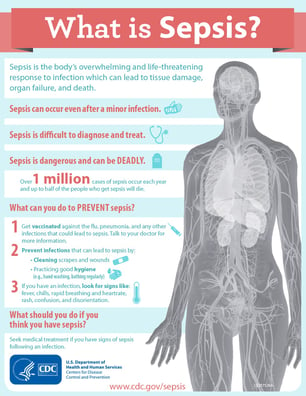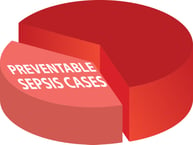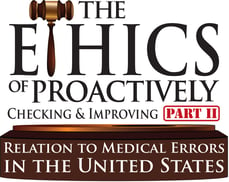
The recent unfortunate and untimely deaths of Patty Duke in March and Mohammad Ali this month have spurred much discussion in the media and increased public awareness regarding the topic of sepsis.
Below, we've posed questions for you to ponder.
Requested are your thoughts and opinions, which will be addressed in Part II.

Why sepsis in the media is important:
Sepsis is a medical condition unknown to many healthcare consumers in America and, as previously mentioned, infrequently in the media.
Interesting that the general public have less than ideal awareness given that according to a Healthcare Cost and Utilization Project (H-CUP), sponsored by AHRQ, recently released a medical brief, sepsis is the most costly healthcare condition treated in hospitals (3), costing $23.7 billion dollars in 2013 and making up the highest percentage spent on hospital stays second only to live births. (3)
Sepsis has a mortality rate of 15-30%; and if it progresses to severe sepsis/septic shock, the mortality rate is 50%! (4)
Significant statistics, given that relative public awareness is low.
A poll done on behalf of the Sepsis Alliance Foundation showed that only about 50% of Americans were aware of sepsis. (5)
Why doesn’t sepsis get media attention?
For starters, it can be complicated to understand and is certainly complicated to treat.
Sepsis is a combination of sequelae related to an existing infection, and the people most at risk of acquiring it are often in a weaker or medically compromised state already.
The morbidity & mortality of those impacted may be often attributed to their primary ailments, medical conditions or to the infection that caused the sepsis.
The definition of Sepsis:
The CDC defines sepsis as “the body’s overwhelming and life-threatening response to infection which can lead to tissue damage, organ failure, and death” (1) and says that those most likely to encounter it include “Those with weakened immune systems, infants, the elderly, those with chronic illnesses, and those with severe wounds or burns.” (2)
Treating sepsis and septic shock involves treating the primary infection with high-dose antibiotics and then treating severe sepsis/septic shock with vasopressors, respiratory ventilation, surgery, etc.
The treatment for sepsis and septic shock is lengthy, intensive and costly.
 The deaths of Mohammad Ali and Patty Duke recently brought sepsis into the media and have, therefore, raised awareness about this complicated, costly condition in the general public.
The deaths of Mohammad Ali and Patty Duke recently brought sepsis into the media and have, therefore, raised awareness about this complicated, costly condition in the general public.
Some questions to ponder:
1) If sepsis is the most costly hospital condition, how often is it hospital associated?
According to a large retrospective study published in Critical Care Medicine, only about 1/3 of sepsis is hospital associated or acquired. (6)
This means that 1/3 of patients with the diagnosis of sepsis/septic shock acquired an infection while in the hospital that led to sepsis.
Does this estimate sound accurate based on your experiences?
2) Might this mean that 1/3 of sepsis cases are preventable????
If the cases are related to HAIs, then it would make sense if the number of HAIs were decreased, then the number of sepsis cases would likely decrease.
Why might this not be the case?
3) How should hospitals respond to public-heightened awareness, and what are we doing to educate healthcare consumers and to prevent hospital-associated sepsis?
What has your hospital done in response?
Post your thoughts or additional questions in the comments, and we will explore them in Part II of this blog.
Credits:
- http://www.cdc.gov/sepsis/
- http://www.cdc.gov/sepsis/pdfs/sepsis-fact-sheet.pdf
- http://www.hcup-us.ahrq.gov/reports/statbriefs/sb204-Most-Expensive-Hospital-Conditions.jsp?utm_source=AHRQ&utm_medium=AHRQSTAT&utm_content=Content&utm_term=HCUP&utm_campaign=AHRQ_SB_204_2016
- http://www.medicinenet.com/sepsis/page7.htm
- http://rorystauntonfoundationforsepsis.org/2471/new-survey-shows-americans-never-heard-sepsis-despite-sepsis-costly-hospital-condition-u-s/
- http://www.ncbi.nlm.nih.gov/pubmed/26110490
Previous Post: The Ethics of Proactively Checking & Improving, Part 2
